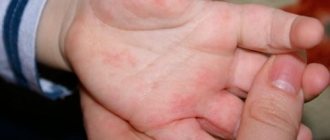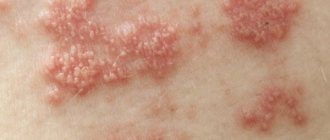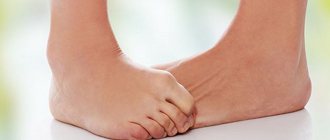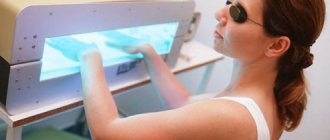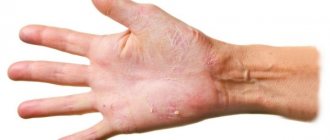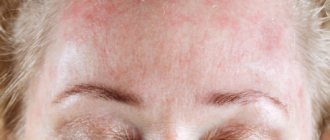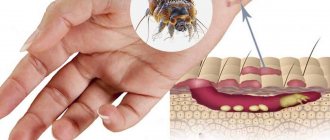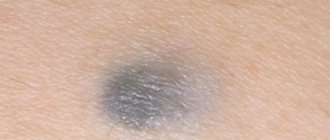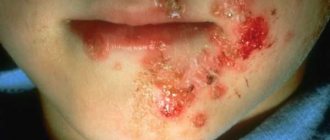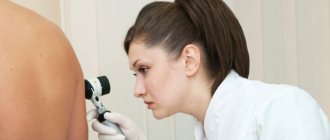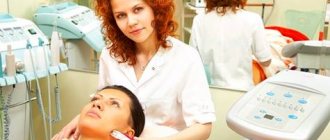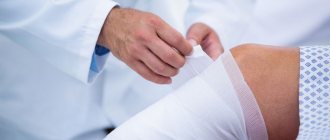Causes
The provoking factors for the formation of purulent rashes on the skin are considered to be:
- infection in an open wound, often observed when scratching acne;
- violation of personal hygiene rules;
- metabolic disorders;
- hormonal imbalance;
- the presence of inflammatory processes in the body.
The appearance of pustules can be accompanied by: herpes, scabies, acne and psoriasis.
The most vulnerable to the appearance of purulent rashes are those who are exposed to frequent hypothermia or overheating, receive insufficient amounts of vitamins, or have diseases:
- diabetes;
- dysfunction of the central nervous system;
- allergy;
- disorders of skin secretion production.
How to get rid of ulcers
Good skin care helps you avoid acne. It is advisable not to use cosmetics that block pores. It is recommended to wash your face twice a day and shower with liquid antibacterial soap.
Beautiful and clean skin should be protected, because pustular acne on the face is unpleasant not only because it takes a long time to mature and hurts. They often leave noticeable spots and scars.
You should cleanse your face with moisturizing lotions, tonics, cosmetic milk or herbal infusions - nettle, St. John's wort, hops. They reduce inflammation and act against bacteria. Aloe has the same effect. Aloe Vera or agave leaves are washed, the juice is squeezed out and applied to acne.
Infectious agents
The manifestation of pustular diseases (pyoderma) is provoked by microorganisms that are endowed with the ability to penetrate the upper layers of injured skin. Most often these are streptococci and staphylococci. But the following microorganisms can also become provocateurs:
- Escherichia coli and Pseudomonas aeruginosa;
- gonococci;
- pneumococci;
- Proteus vulgaris;
- mycoplasma.
Human skin contains a large amount of fatty and protein ingredients, which promotes the activity of microorganisms. Streptococci and staphylococci are always present on the skin and pose a danger only when they penetrate into the deep layers of the epidermis or when the immune defense is reduced.
In the presence of pustular diseases, the composition of the bacterial flora on the skin changes, which can provoke the formation of new lesions.
Causes of purulent acne
- Increased secretion of subcutaneous fat. The cause is hormonal imbalances or diseases of the internal organs. Due to the increased work of the sebaceous glands, which produce fat in large quantities, the skin becomes clogged and acne occurs.
- Hyperkeratosis, thickening of the skin layer. When fat forms, active proliferation of bacteria and suppuration of the skin occurs.
- Abuse of antibiotics, steroids, hormone-containing drugs and contraceptives.
Menstrual cycle and pregnancy.- Negligence in maintaining hygiene rules, uncleanliness.
- Abuse of decorative cosmetics.
- Stress and other nervous conditions.
Characteristic features of furunculosis
Furunculosis must be understood as a pathological condition characterized by damage to the hair follicles and sebaceous glands. Furunculosis occurs more often in men. Areas of localization of rash elements are:
- neck;
- nose;
- pelvis;
- armpits;
- face.
The pathological condition has several stages:
- Infiltration – the appearance of skin hyperemia, swelling, and thickening is observed.
- The formation of a nodule - over time it turns into an abscess. The stage is accompanied by the appearance of pain upon palpation of the affected area, the accumulation of purulent exudate, and the formation of a rod.
- Healing – there is an opening of the abscess, a weakening of the intensity of pathological symptoms, and an improvement in well-being.
The main symptoms of furunculosis
- increased body temperature;
- the appearance of pain upon palpation;
- feeling of general weakness;
- headache.
In the absence of timely treatment, there is a risk of developing complications in the form of meningitis or sepsis.
Course of carbunculosis
Carbunculosis is characterized by the formation of ulcers that affect several follicles at once. The pathological condition appears most often in the warm season. The main areas of localization of ulcers are the face, appearing between the shoulder blades, on the buttocks, and neck.
The size of the carbuncle reaches several centimeters, its maturation period lasts 7-10 days. The pathological condition is accompanied by increased body temperature and pain. Carbuncle requires surgical treatment.
Sycosis
The disease more often affects men; neuroendocrine disorders are considered to be the provoking factor. Its formation is often associated with chronic rhinitis and conjunctivitis. The main areas of localization of ulcers are:
- nasal mucosa;
- chin skin;
- area above the upper lip;
- wings of the nose;
- brows;
- eyelids;
- pubic area.
Often the formation of ulcers is observed on the scalp of the face. The first symptoms are the appearance of hyperemia - the formation of grouped pustules that contain pus in their cavity. This process is called folliculitis, it spreads to adjacent areas, first affecting the superficial layers of the skin.
Ulcers can disappear on their own and appear again. The long course of sycosis is characterized by the formation of deep folliculitis. The pathological condition is characterized by the following symptoms:
- swelling;
- skin hyperemia;
- soreness of the affected areas.
After opening the abscesses, the formation of a yellowish crust is observed.
Other pustular diseases
Impetigo vulgaris is considered mixed pyoderma; it is contagious. The process extends to the skin and its appendages. First, the appearance of hyperemia is observed, later in its place bubbles filled with serous contents appear - phlyctenas. Over time, the contents become purulent and dry out, forming crusts. One of the common areas of localization of pyoderma is the face.
Abscess
Ulcers on the skin can appear as an abscess. It is characterized by the formation of an inflammation process and a cavity that fills with pus. It is most often localized on the limbs, neck, head, and in women - in the axillary area. Women often complain that they have ulcers after sugaring. This can occur if the rules for disinfecting the instruments used are not followed, as well as due to ingrown hairs.
This pathological condition occurs as a result of a violation of the integrity of the skin and the penetration of bacteria. The clinical picture appears:
- pain in the affected area;
- hyperemia;
- fluctuation;
- rapid heartbeat;
- swelling;
- increased temperature;
- tubercles, depressions on the skin.
First, the appearance of redness is observed, which subsequently turns into an infiltrate and an abscess with leukocytes, living and dead microorganisms. The pathological condition is dangerous because it can cause the spread of infection.
Where do pimples appear on the body?
On the face
The reason for the appearance of purulent acne on the face is dense blockage of the sebaceous ducts of the skin with subcutaneous fat. Pus in this case is a product of the decay processes of bacteria accumulated in sebum. Such pimples are painful, appear suddenly, growing from small, barely noticeable lumps to a large blackhead with a purulent core in the center.
On the head
Purulent pimples on the head cause discomfort when scratching, flaking and itching. Such acne occurs due to the hair retaining heat from the scalp, coupled with the production of surface oil - this creates a very favorable environment for the proliferation of bacteria and their penetration into the scalp.
On the back
Purulent acne on the back appears in the form of red inflammations, which are swollen tissues with suppuration.
Types of dorsal purulent acne:
- papules - the mildest form, resemble balls in appearance, red in color;
- pustules - red inflammation with a purulent ball inside;
- nodes - inflammation goes deep into the skin;
- cysts - inflammation of a bluish color, painful sensations occur on palpation.
On the lip
Pimples on the lips occur due to bacteria entering the skin pores.
They are white and small in size. In mature pustules, the head is clearly visible. Causes of purulent pimples on the lips:
- improper skin care;
- use of expired, low-quality decorative cosmetics;
- failure to comply with hygiene rules, touching lips with dirty hands;
- habit of holding foreign objects in the mouth: pens, pencils, etc.
On the pubic area and intimate places
Purulent rashes in intimate places can be both harmless, occurring during puberty, and serious, resulting from skin or sexually transmitted diseases.
On foot
Reasons for the formation of purulent acne on the legs:
- inflammatory processes caused by viral infection;
- mechanical injuries, for example, during leg hair removal;
- hair growth defects – when a hair grows into the skin;
- problems with blood vessels, varicose veins.
On the forehead
Reasons for appearance:
- problems with the gastrointestinal tract;
- non-compliance with the principles of proper nutrition;
- hormonal changes;
- reduced immunity;
- frequent face washing;
- allergies, skin irritation from using new cosmetics;
- poor facial skin care.
On the chin
The appearance of purulent acne on the chin is associated with internal problems. Usually, these are disturbances in the functioning of the endocrine system.
On hands
A common reason for the appearance of purulent pimples on the hands is excessive dryness of the skin, which occurs due to constant friction from clothing, as well as due to changes in the hormonal levels of the body.
On the chest
Reasons for appearance:
- disruption of the functioning of internal organs and systems of the body;
- frequent wearing of clothes made from synthetic materials;
- neglect of hygiene;
- diseases of the gastrointestinal tract, endocrine system, genital organs;
- poor nutrition;
- constant nervous tension;
- long-term use of antibiotics;
- allergy.
On the butt
Causes:
- excessive dry skin in the buttock area;
- insufficient oxygen supply to the skin;
- sedentary, sedentary lifestyle;
- hormonal imbalances;
- prickly heat, allergies;
- hypothermia;
- venereal diseases;
- reaction to new food, cosmetics, cleaning products.
In the nose
Purulent pimples in the nose occur due to bacterial and viral infections entering this area. As a result, the mucous membrane is damaged, the microflora of the nasal mucosa is disrupted and acne appears.
On shoulders
The shoulders, often covered by clothing, can be affected by purulent pimples due to excessive sweating, rubbing with fabric, lack of oxygen due to covering the shoulders with long hair.
Also, the cause of the appearance of pustules on the shoulders may be non-compliance with hygiene rules and excessive use of tanning.
On the neck
The main reason for the appearance of purulent acne on the neck is a side effect of taking hormone-containing drugs, steroids, and contraceptives.
On the stomach
Purulent acne on the abdomen is a consequence of infectious diseases:
- measles;
- chicken pox (colloquially “chicken pox”);
- rubella;
- syphilis.
Therapeutic measures
For treatment to be effective, it is necessary to find out the causes of the pathological condition and direct efforts to eliminate it. Recommended:
- normalize the functioning of the digestive tract;
- restore hormonal balance;
- maintain personal hygiene;
- avoid stress;
- maintain a balanced diet.
An important step is cleansing the skin; for this you can use scrubs and homemade masks. You also need to contact a cosmetologist who will prescribe a course of procedures that will help dissolve sebaceous plugs, as well as exfoliate dead epidermal cells. The most effective procedures are considered:
- ultrasonic cleaning;
- chemical peeling;
- cryotherapy;
- mesotherapy.
Chemical peeling of the face
Attention! Procedures can be started only after the inflammatory process has been eliminated. Otherwise, there is a risk of spreading the infection.
Drug therapy
In complicated cases, it becomes necessary to prescribe antibacterial drugs. Most often used:
- Unidox Solutab.
- Erythromycin.
- Tetracycline.
- Doxycycline.
The selection of medications, dose, and duration of treatment is carried out by the doctor.
In parallel with this, the following are prescribed:
- Retinoids, which eliminate excess activity of the sebaceous glands and regenerate epithelial tissue. The drugs of choice are Tretinoin, Adapalene, Isotretinoin.
- Sorbents, dietary supplements with lactobacilli. The products help normalize the intestinal microflora, removing toxic substances from the body. This group includes medications: activated carbon, Polysorb, Linex, Lactofiltrum.
- Vitamin and mineral complexes. These include vitamins: E, A, C, as well as zinc.
Topical agents are also used, but only after consultation with a doctor. Effective are:
- Iodine. It is used for spot application to affected areas; it eliminates the inflammatory process and disinfects well.
- Zinc ointment. The drug has a wound-healing effect, prevents tissue necrosis, and protects against the negative effects of pathogenic microorganisms.
- Levomekol. It is recommended to apply the product to the affected areas for 2-3 hours, then rinse with water.
- Salicylic acid. Effectively fights bacteria, eliminates hyperemia and dead cells.
- Alcohol tincture of calendula. Has a wound-healing, anti-inflammatory effect.
Also, the effect is observed from taking baths with sea salt or potassium permanganate; they have a disinfecting and drying effect. Do not use hot water.
The use of folk recipes
Before using folk remedies, it is recommended to consult a doctor. The following is considered effective:
- Aloe juice helps draw out pus. A plant leaf, without the top skin, is applied to the affected area. You need to leave it on all night, so that it does not slide off, it needs to be attached with a band-aid. In severe cases, the procedure is performed several times.
- Calendula infusion. To prepare 1 tbsp. l. raw materials are poured with 500 ml of boiling water and left for 30 minutes. The infusion is used to wipe the skin. If you add honey to it at the rate of 1 tsp. per glass of solution, then it can be used for lotions. To do this, soak a cotton pad in the solution and apply it to the affected area for 20 minutes.
There is a second way to prepare the tincture. To prepare it you need 2 tbsp. l. pour calendula flowers with 50 g of alcohol, 40 g of water, 80 g of cologne. The mixture is left in a warm place, and then 1 tsp is added to it. 5% boric alcohol and ½ tsp. glycerin. Wipe the affected areas with the product twice a day.
- Fresh leaves of birch, nettle, dandelion root and burdock. You need to take 2 tbsp. l. mixture, pour 500 ml of boiling water, boil for 15 minutes, strain and cool. It is recommended to drink 100 ml of the decoction three times a day.
- Onion applique. In order for the pus to come out faster, you need to apply a baked onion to the affected area and secure it with a band-aid. It is better to leave the application overnight.
Prevention
Following the rules will help prevent the formation of ulcers:
- rational nutrition. The diet excludes the consumption of fast food, fatty and salty foods, spices, marinade, mayonnaise, sugar, wheat, and milk. Preference should be given to fruits, vegetables, herbs, vegetable oil, and dairy products. From grains it is better to eat buckwheat, oatmeal, bran;
- physical activity. You need to spend as much time as possible outdoors;
- personal hygiene. You need to take a shower or bath every day, having several towels - for the face, hands, feet, head;
- washing bed and underwear;
- socks of things that should be made from natural fabrics;
- use of hypoallergenic cosmetics that should not contain comedogenic components.
Attention! It is forbidden to squeeze out pimples on your own; this can cause serious complications. The painful hyperemic elements of the rash should also not be touched. Any damage to the skin must be immediately treated with antiseptic solutions to prevent the addition of bacterial microflora.
It is necessary to start treating ulcers on the body only after examination by a doctor. Self-medication can cause deterioration of the condition and the development of very serious complications.
How to treat?
Any pimples on the body, especially purulent ones, need to be removed as soon as possible. But in order to get rid of the problem as quickly as possible, you should consult a doctor and follow all his instructions. An individual plan is drawn up for each patient, taking into account the nature of the pathology and the characteristics of the body.
Traditional treatment
Milia on the face of newborns does not require treatment, as they disappear on their own. It is recommended to carry out normal hygiene procedures; you should not pierce or squeeze out white pimples. It is also prohibited to remove other pustules on the face yourself, so as not to provoke the spread of infection and the development of dangerous complications.
Medicines play a major role in the treatment of purulent acne. With the help of drugs, it is possible to kill the pathogen, reduce the activity of the inflammatory process, clean the wound and speed up healing. The following drugs may be present in external therapy regimens:
- Antiseptics (salicylic alcohol, brilliant green, potassium permanganate, fucorcin, iodine solution).
- Antibacterial (chloramphenicol, erythromycin ointment, Levomekol, Dioxyzol, Gentaxan, Chlorophyllipt).
- Antifungals (Lamisil, Exoderil, clotrimazole).
If these remedies are sufficient for superficial pyoderma, then deep and widespread processes require systemic therapy with antibiotics (penicillins, cephalosporins, aminoglycosides), immunomodulators (antistaphylococcal plasma, gamma globulin), and detoxification agents. Microsporia requires the prescription of griseofulvin; scrofuloderma is treated with antituberculosis drugs.
In the complex treatment of recurrent pyoderma, physiotherapeutic methods are used - UV irradiation, UHF, electro- and phonophoresis, laser therapy. Large abscesses are opened surgically, washed with antiseptic solutions and bandaged with antibacterial ointments until complete healing.
